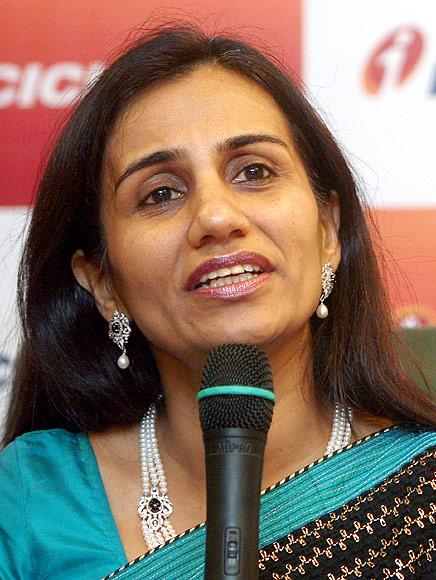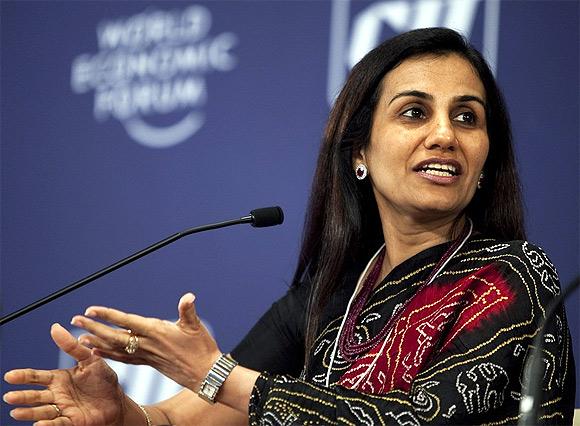Photographs: WEF/Wikimedia Commons Devina Joshi & Dev Chatterjee
Anand Mahindra and Chanda Kochhar share their views on what ails India's innovation climate and how to fix it.
In markets disrupted by constant change and a relentless quest for efficiency, one of the most coveted corporate virtues is innovation. But many of the pillars of corporate success - hierarchy, repeatability, lowering the possibilities of failure - can end up killing the spirit of innovation.
So how does a successful company build and sustain an environment in which risk-taking is not stymied and new ideas can thrive?
Anand Mahindra, chairman, Mahindra Group, and Chanda Kochhar, MD & CEO, ICICI Bank, talk about how India Inc could improve its innovation quotient and how encouraging risk-taking is an important part of the equation.
Would you agree that Indian corporations are way behind their Western counterparts when it comes to innovation? Given that Indian engineers are powering Silicon Valley, why don't we have a Google or a Facebook springing from India?
Anand Mahindra: It is really about competition. It is about allowing the ecosystem here to compete with the world for everything.
If you look at the past, we stagnated as an economy because of a lack of competition. People asked us why we were not investing more in R&D in India.
To allow the world's best to compete here we have to ensure that the barriers to business vanish here.
Second, we seem to have a bias against consumerism here. Somehow, there is this inbuilt socialism in us. But if you look at the most interesting innovation, it comes from encouraging people to consume.
When people consume, they want more, then they choose the best, and you suddenly get innovation coming in. Now, combine that with desperation and people wanting to get a better life, you have a potent combination for innovation.
Chanda Kochhar: One important ingredient that we haven't touched upon is the Indian consumer. When we in our sector talk of the adoption of Indian consumers to new products and innovative ways of doing banking, they always exceed our expectations.
In India, we have the opportunity to give innovation the kind of scale that no other country in the world can. Innovation is a necessity.
India did not innovate with the ATMs. But when we brought ATMs into India and made the machines talk in 15 regional languages to the people in rural India, we got millions of transactions on the ATM.
Facebook has been around, but can you complete a banking transaction on social media? We made that happen. India is among the countries that are most ahead in terms of the percentage of banking transactions on electronic channels as opposed to those in the physical branches.
If you take existing ideas and make them affordable and scalable, you substantially change business models. India lacks an education system that is research and creativity oriented.
We need to build this culture of innovation before individuals actually join organisations. Second, we don't have the financial ecosystem...those angel investors who are willing to put their passion and money behind it.
…
Anand Mahindra, Chanda Kochhar on why India fails in innovation
Image: ICICI Bank CEO Chanda Kochhar.Photographs: Reuters Devina Joshi & Dev Chatterjee
So you are putting the blame squarely on the education system in the country for not fostering a spirit of innovation among people who are entering the workforce?
Kochhar: The education system needs to add a lot of creativity for starters, and then get into research as we go up the curve.
The education system is very examination-oriented but an application of that knowledge is lacking. How much are we adding on the ability to think differently and apply basic knowledge into different models and research?
The other thing you said was the absence of an ecosystem that can encourage innovation in India…
Mahindra: I think we're getting there. Take ICICI Ventures for example, which has done extremely well.
…
Anand Mahindra, Chanda Kochhar on why India fails in innovation
Photographs: Reuters
What have you done at an organisation level to encourage a culture of innovation? Google, for instance, encourages employees to spend about 20 per cent of their time experimenting with their own ideas. Do we have any such example of a more casual and unorthodox approach to management in India that is so typical of the Valley?
Chanda Kochhar: In our company, we want people to come up with ideas. In fact, we track the number of ideas people come up with, which in a way becomes a rewarding factor for them.
You have to have a process where these ideas are seriously looked at and filtered to be taken forward. We have an Innovation Council, which looks at those ideas and picks up a few of them that are taken for further application.
Innovation in any company has to work both ways - top-down as well as bottom-up. When it comes to bottom-up, here is what we ask people to do: look at technology, look at what your customers want and come up with ideas. At the same time, you may want to try out two or three major themes as a CEO, which will then be the top-down approach.
For example, digitisation and mobility is changing the world, so I want all my products to convert into digital and mobile.
But an employee may say, if we have this on the internet, why don't we have it on smartphones, or can we not combine it to give a customer a seamless experience? What are the five different things that the 18-year-old is looking for when he looks at internet banking, rather than just a 35-year-old?
…
Anand Mahindra, Chanda Kochhar on why India fails in innovation
Photographs: Courtesy, Mahindra
Mahindra: We have an annual leadership conference with around 500 people, and our theme last year was innovation. I proposed a '5S' framework. I divided them into two things: Two of the S's were in the sphere of context creation.
These include 'space'. I said, we're living in a world where we don't give ourselves enough space. We're always on this device (points to his smartphone), we're always working and thinking we're being innovative but we're not.
Sometimes the only kind of innovation comes when you have some solitude; when you step away. If Newton hadn't been lolling under the tree, the apple wouldn't have fallen on his head, you know. He was goofing off frankly!
The second 'S' is what I call 'self-indulgent creativity' - give everyone time. Ask them to do some work which has nothing to do with the business objective. Some innovation which has nothing to do with producing a better car, for example.
The other three S's are 'simplicity', and then a French word 'sans', which means constraints, or without money - doing more with less, and the last S is 'sustained experimenting' - keep at it.
The Samsung microwave story is an example there. They kept at it, despite a number of things that bombed.
Those are the five S's. Did anyone listen? I wasn't too optimistic, but then I got an email from our head of R&D in auto, who said he was using the '5S' framework, including allowing the context. I think it is happening.
Have we reached the point where we have people goofing off under trees? I don't know. But I hope people are giving time and allowing their minds to be open to questioning.
…
Anand Mahindra, Chanda Kochhar on why India fails in innovation
Photographs: Courtesy, Mahindra
Foreign direct investment (FDI) can give a big boost to innovation in new products, according to R Gopalakrishnan (Tata Sons). Where do you stand on this debate?
Mahindra: I have no problem with money coming in and spawning competition. I am honest enough to admit that Mahindra & Mahindra would not have been going to the IITs and doing research, if there was no competition.
We're rational animals after all. Why would I spend more money, if I wasn't pressured by competition to do so? The more the FDI, the more the competition. In principle, I am in favour of it.
Kochhar: Innovation gets driven by both constraints and opportunities. A constraint could even be competition, which drives you to innovate. Without getting into the ownership structure, I would say, how much are you learning from what is happening around the world so that you innovate?
You learn from how the customer lives her life and how technology makes things possible.
As a bank, you can learn from even the hospitality industry and say, this is how service is measured.
You can even learn from the automobile industry and say, this is how a back office operations shop should work. The ways of learning are tremendous; ownership structure is just one of them.
...
Anand Mahindra, Chanda Kochhar on why India fails in innovation
Image: Chanda Kochhar.Photographs: WEF/Wikimedia Commons
Experts talk about disruption these days. What are some of the challenges you foresee in this context for companies like yours in the coming years?
Kochhar: The way to look at it is, what are those emerging trends which will impact your business model.
As a bank, we look at the impact of mobility and digitisation, and if every bit of your product and your channel does not adapt to mobiltiy in time, your existing business models will get disrupted.
So instead of looking at what are the constraints, you have to look at what are the driving factors that keep pushing you to innovate, so that you aren't left behind.
Mahindra: You have to seed internal disruptors. You need sources of internal disruption. They don't guarantee your survival but you have got to try.
One of those internal disruptors that we have is called the Shadow Board. All our group companies are required to form a Shadow Board made up of people under 35 years of age, who are to meet quarterly and behave like if they were the Board of Mahindra, what they would be doing differently.
One of the classic examples of their performance is, when we were not bidding for Punjab Tractors at one stage. At our annual conference, during these Shadow Board presentations, one of them did a very interesting skit. They pretended that they were from a competitor, and they play-acted as if they had bought over Punjab Tractors.
They demonstrated that if they bought it and Mahindra didn't, what would happen in the market. I had never thought of this way.
We had been looking at IRRs (internal rate of return), our walkaway price, our strategic synergy value etc. And I came away frightened out of my mind.
I have no doubt in admitting that all of us there who eventually bought Punjab Tractors were affected by that, because a bunch of people took the time out to think about what would happen if we didn't. Punjab Tractors today is among our most successful acquisitions.
...
Anand Mahindra, Chanda Kochhar on why India fails in innovation
Image: Reva carPhotographs: Courtesy, Mahindra
Second, why did we buy Reva? We wanted internal disruption. Why would somebody making diesel-based products buy an electric car product when there was no viable business for it?
Even then, we are often asked in the media about how many cars have been sold in a month, and that the strategy doesn't seem to be working. How about saying that the one disruption in the automotive industry today is Tesla?
When the future comes, it doesn't come with a very long overture; it comes with the curtain just about rising. Or dropping. Today, if someone says Tesla is going to disrupt the automotive universe, I'll answer, "Not Mahindra!"
Kochhar: An example I can give is something that we came up with last year at ICICI called 'Youthisation'. When I coined the word, I didn't know if such a word existed.
This means I want 'x' number of 25-year olds who will look at each of our products and channel interfaces and tell me whether the 18-year old wants to interact with us on these. It is working well.
It is okay for us to believe that the 35-year old finds our website useful and interacts on that, but does the 18-year old, who will be my customer three years later, even know what ICICI is all about and that we are present on Facebook?
Are we touching that part of his mindset? Even if they are not our current customer, they are influencers today and will be customers tomorrow. I ask my team to look at every product and every channel, and whether we can 'Youthise' them.
...
Anand Mahindra, Chanda Kochhar on why India fails in innovation
Image: Gurumail Singh Dhonsi, a farmer from Rajasthan, invented a Rapid Compost AeratorPhotographs: Courtesy, NIF
In India, we do not celebrate failures enough like they do in many Western cultures - a sure deterrent to innovation. How would you like to change that, given the chance?
Mahindra: It comes from the home. First ask yourself, how are we as parents? When I look back, I frankly think I failed at not being tolerant enough. I constantly had a vision of what I wanted my kids to be; I wanted them to measure up.
How do we get to a point where children feel that there is no gravity pulling them down by our expectations?
If you have a child who has grown up only respecting authority, then it boils down to the school. But when it comes to encouraging individuals to question things, it comes from parenthood, then the school.
Today, most of our schools don't reward imagination, and this is at the root of the rot in our society. We can talk about infrastructure and ecosystem, but how are we as parents and teachers?
Only then can we move on to the Tatas and Mahindras celebrating failure. Then I can ask, as a CEO, am I still making the mistakes I committed as a parent, or am I genuinely listening? Am I just simply saying I celebrate failure, and when somebody fails do I say, "Fire the guy"?
Kochhar: What do we mean by 'celebrating failure'? I think it means that we have to be tolerant towards failure and celebrate the ideas and the learnings. Failure has to lead to learnings. That is what we need to celebrate.
Many scholars describe the Indian way of innovation as an extension of the Indian tradition of jugaad: developing improvisations and make-dos to get around the issue of scant resources to solve seemingly insoluble problems.
The term jugaad has also assumed a connotation of 'compromise on quality'. Do you subscribe to this view?
Mahindra: Low-cost innovation is essential for solving many problems facing the country. We should not confuse jugaad with frugal innovation.
Jugaad does imply a positive 'can-do' attitude, but unfortunately, also involves a 'make-do' approach. It can, hence, lead to compromises on quality and rarely involves cutting edge or breakthrough technology.
'Constraint-led Innovation' is a better approach. It targets the most advanced technology but with a philosophy of 'more for less'.
The time has come for India to move from 'jugaad' (somehow) to 'jhakkaas' (superb).










article